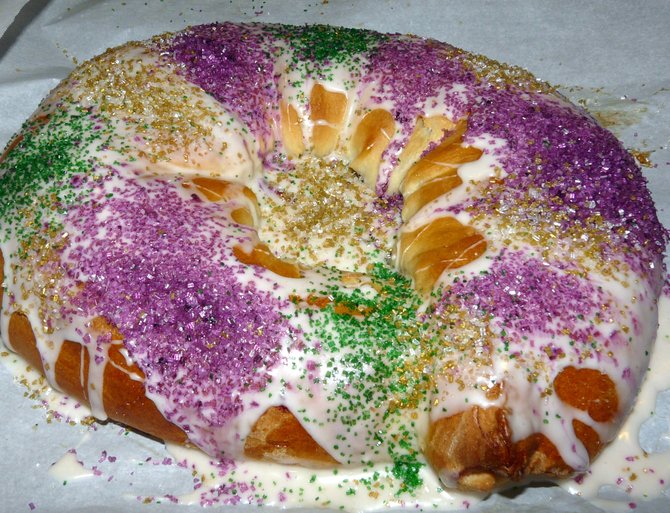It's time to say farewell to fresh king cakes once again. As the scent of flaky dough and sweet icing fades from local bakeries and we polish off the last slices, many of us are already looking forward to next year, when the seasonal treat comes back again. Now is as good a time as any to consider: How well do you really know the green, purple and gold treat? Test your king cake knowledge so you'll be ready when Carnival season 2014 rolls around.
- What do the three colors of icing stand for?
- What does the circular shape represent?
- What is Mardi Gras actually leading up to (hint: we're in it now)?
- What small trinket is often hidden in the cake or included with it?
- What does the recipient of said trinket have to do?
- Where does the name "king cake" come from?
Find the answers at jfp.ms/kingcake
Easy King Cakes
by Michele Breaux
If you simply can’t wait a year to eat another king cake, try making your own. This recipe makes three cakes—plenty to share with friends.
Cake:
1 tablespoon sugar
4-1/2 teaspoons yeast
1/2 cup warm water (105 to 115 degrees)
2 cups milk
10 tablespoons butter or shortening
2 teaspoons salt
2 egg yolks--save whites for egg wash
1/2 cup sugar
6-1/4 to 7 cups flour
Cinnamon, as desired
3 12-1/2 ounce cans cake filling (can be found on the baking aisle in several flavors--note: it's not the same thing as pie filling!)
Topping:
3 cups powdered sugar
1/2 teaspoon vanilla extract
3 to 4 tablespoons water
colored sugars: green, purple and yellow
Place yeast in a medium bowl and sprinkle with one tablespoon sugar. Stir in 1/2 cup warm water (if water is hotter than 115 degrees it will kill the yeast) to dissolve sugar and mix yeast in well. If you don't have a thermometer, water should feel warm but not hot on your wrist. Place bowl in a warm place and let the yeast mixture double in size; it should take about 30 minutes.
Meanwhile, heat two cups of milk. Melt the butter in warm (not hot--remember the 115-degree limit) milk. When milk has cooled, whisk in two egg yolks, half cup sugar and two teaspoons salt, and add to yeast mixture.
If you are using a mixer, attach a dough hook. While mixing, add flour slowly to yeast mixture until dough is glossy but not sticky. This can be as much as seven cups of flour. Move dough into an oiled or buttered bowl, turning to oil all sides. Cover with a damp cloth and put in a warm place to rise until doubled, 45 minutes to one hour.
After dough has doubled, punch down and divide into three. Roll or pat out each section on a floured surface into a 16-inch by 10-inch rectangle. Sprinkle with cinnamon. Spread one can of filling onto each rectangle. Don't go all the way to the edges, or it will squeeze out. Roll it up jelly-roll style into a long snake shape. Gently twist this roll into a wreath shape and pinch ends together. Repeat with all three sections of dough. Place seam-side down on baking sheets and let rise in a warm place for 45 more minutes.
Preheat oven to 375 degrees. Make an egg wash by adding two tablespoons water to the saved egg whites. Whisk until smooth and brush over tops of cakes. Bake cakes for 20 to 25 minutes, until golden brown. Let cakes cool.
To decorate, make a glaze from three cups powdered sugar, a half teaspoon vanilla extract, and enough water to achieve desired consistency. Decorate cakes with colored sugars.


